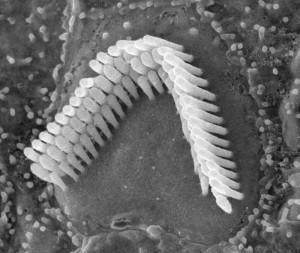THURSDAY, 3 FEBRUARY 2011
Deafness is commonly caused by defective microscopic hair cells in the cochlea, which are necessary for transducing sound into neural signals. The complex developmental pattern of these hairs in humans and other mammals is known to involve a micro RNA, miR-96. If the gene for miR-96 is mutated, development does not occur correctly and the hair cells are non-functional.The research group, involving scientists at the University of Sheffield’s Department of Biomedical Science and the Sanger Institute in Cambridge [1], used a strain of deaf mice called diminuendo, with a single base mutation in the miR-96 gene. They found that this micro-RNA controls the activities of a number of genes, so that miR-96 in fact centrally regulates hair cell development. Not only does miR-96 govern the formation of hair cells and their mechanical sensitivity, but also synaptic development at the bases of cells.
The discovery of this genetic master controller, and some insight into the precise mechanisms it is involved in, give an opportunity to affect the molecular processes which lead to deafness. Micro-RNA molecules can be affected by drugs, and it is possible that treatments could be developed which would save the hearing of thousands of people.
Written by Natalie Lawrence

